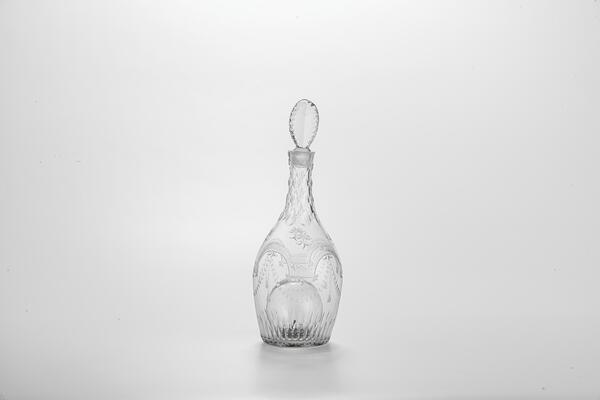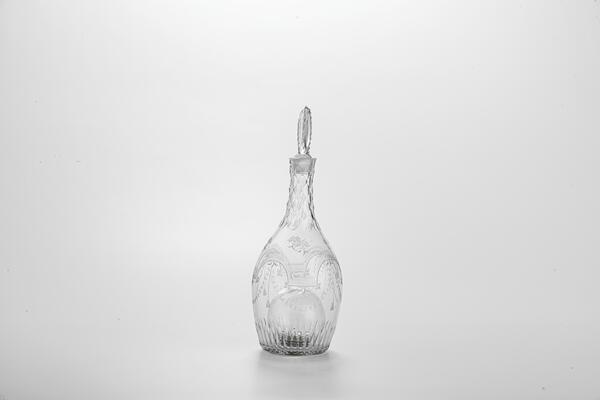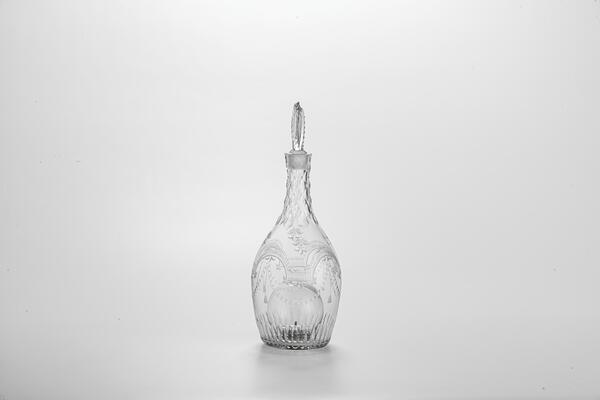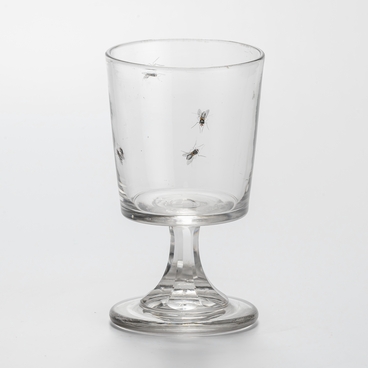A decanter-refrigerator stands out among the extraordinary exhibits dating from the late 18th to the first half of the 19th century. Its appearance does not provide any clues to the secret device hidden inside. This is an example of blown glassware which is traditional in shape: the ovoid body has a flat bottom and a narrow neck. The body of the decanter is adorned with clear and matte engraved motifs typical of the era of Сlassicism. Small vertical grooves make arches, which are in their turn interconnected by the same kind of horizontal grooves. There are images of stylized flowers above and below the arches. The lower row of flowers with long matte tassels is supported by four garlands, “woven” from matte hatching and light shallow pits. The garlands are interconnected and surround the decanter’s body with a continuous pattern. The neck is trimmed with a “fish scale” pattern. There are small notches along the edges of the flat leaf-shaped stopper, and there are two vertical finger-like facets on both sides. The facets were obtained with the help of special cutting discs and blade plates. Depending on the shape of the disc, the cut patterns can vary in width and depth, be sharp or rounded.
The glass from which the decanter is made is quite pure and clear. Its good state indicates that high-quality raw materials were used for the product. However, the decanter also has a functional feature that becomes visible only if you look inside.
The craftsman blew a spherical glass bubble from the bottom into the vessel. The bottom of the bubble is closed with a metal lid with a stopper. This is a secret cooling device. Crushed ice was placed in there, tightly closed with a lid with a stopper, and wine or some other drink was poured into the decanter. After some time, condensation appeared on the surface of the decanter — this was a signal that the drink had cooled enough and it could be served on the table.
Apparently, highly skilled craftsmen, whose names remain unknown, manufactured this decanter-refrigerator.
The glass from which the decanter is made is quite pure and clear. Its good state indicates that high-quality raw materials were used for the product. However, the decanter also has a functional feature that becomes visible only if you look inside.
The craftsman blew a spherical glass bubble from the bottom into the vessel. The bottom of the bubble is closed with a metal lid with a stopper. This is a secret cooling device. Crushed ice was placed in there, tightly closed with a lid with a stopper, and wine or some other drink was poured into the decanter. After some time, condensation appeared on the surface of the decanter — this was a signal that the drink had cooled enough and it could be served on the table.
Apparently, highly skilled craftsmen, whose names remain unknown, manufactured this decanter-refrigerator.





